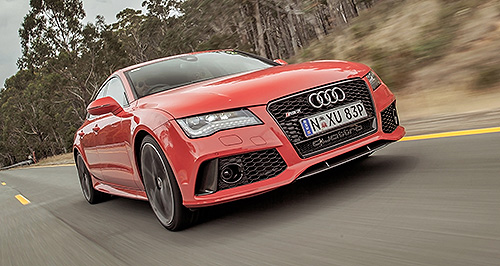Driven: Fiery RS7 heads Audi sports quinella
BY RON HAMMERTON | 19th Feb 2014

The latest arrivals are the big twin-turbo V8 RS7 Sportback – the new flagship for the five-door A7 ‘coupe’ range – and manic RS Q3, a compact SUV propelled by the same blown 228kW five-cylinder engine as the RS TT sports car.
Coming hard on the heels of the latest RS5 Cabriolet and RS6 Avant that were launched in the second half of last year, the two new RS arrivals bring the tally to seven in Australia.
The RS7 becomes the most expensive of these at $238,500 (plus on-road costs), which is $13,500 above the list price of the similarly motivated RS6.
However, the pricing for the RS7 five-door ‘coupe’ is more affordable than BMW’s equivalent $299,145 M6 Gran Coupe and Mercedes-Benz’s $260,654 CLS 63 AMG S.
What’s more, Audi is claiming acceleration bragging rights, saying its five-metre-long, two-tonne luxury sports flagship can cover the 0-100km/h sprint in 3.9 seconds, compared with 4.2 seconds for the Beemer and 4.1 seconds for the Benz.
The Audi’s blown 4.0-litre V8’s output of 412kW of power and 700Nm of torque is similar to the M6’s 412kW/680Nm and less than that of the bigger 5.5-litre, 430kW/800Nm V8 of the CLS AMG S, but the Audi’s faster acceleration can be attributed to its road-grabbing quattro all-wheel drive.
Audi Australia expects to sell only about 20 of the bahn-storming beasts this year, making it one of the rarer Audis on Australian roads.
The RS7 is a first for the A7 range, which previously topped out with the $179,900 4.0-litre V8 S7, packing 309kW of power.
The new A7 flagship uses the same bi-turbo version of the alloy-block V8 as the RS6, with the turbos nestled in the “vee” of the engine, feeding the inlet manifolds on the outside of the engine, in a reverse arrangement to the traditional V8 set up.
This engine gains cylinder on demand, running as a V4 on gentle throttle up to 3500rpm, to save fuel in cruise mode. Audi claims a combined fuel-consumption rating of 9.8 litres per 100km.
Due to the mountain of torque generated by this engine, ZF’s ubiquitous eight-speed automatic transmission is employed in place of the seven-speed dual-clutch S Tronic transmission of other Audis. The RS7’s torque-converter-type transmission has a sports mode, allowing the driver to shift gears with steering-wheel-mounted paddles.
As well, the RS7 has launch control for sling-shot starts, which are further enhanced by close ratios for the first seven gears. Eighth gear is tall to reduce highway fuel consumption.
Audi’s trademark quattro all-wheel drive system is standard. It gets a new centre differential to better vary torque between the front and rear axles.
Usually, about 60 per cent of the drive goes to the rear wheels, but depending on traction, up to 70 per cent can be sent to the front wheels or up to 85 per cent to the rear.
As well, Audi’s sport differential is standard on the rear axle, pushing more torque to the outside wheel when accelerating out of corners.
This sophisticated quattro system is designed to work in conjunction with the torque vectoring system which brakes the inside wheels should they threaten to slip.
The RS7 uses a good measure of aluminium in panels such as the bonnet, doors and rear hatch to keep weight in check, and rides on adaptive air suspension that is set 20mm lower than the standard A7.
This suspension can be ramped up with the optional Dynamic Ride Control which allows the driver to select from four ride modes – comfort, automatic, dynamic and custom.
The alloy wheels are a hefty 21 inches in diameter, and can be had in either regular alloy – called titanium – or black. Behind them, the big 390mm front brake discs are grasped by six-pot brake callipers. The steel discs have a wave pattern around the edge, apparently to save weight. Ceramic discs are optional.
At highway speeds, a rear spoiler rises automatically from the trailing edge of the long, sloping hatch to provide extra downforce.
The long body – sitting on a 2920mm wheelbase – allows a capacious 535-litre boot, expanding to 1390 litres with the rear seats folded.
Those rear seats accommodate only two passengers, making the RS7 a four-seater, but all positions have snug sports seats with honeycomb-pattern quilted leather inserts – mimicking the black honeycomb grille design – in either black or silver.
Interior finishes include aluminium and piano black with carbon inlays. For those who can’t get enough of carbon-fibre trim, the full treatment costs $8500 extra.
Standard equipment includes four-zone climate control, Audi’s MMI in-car control system with sat-nav and touch-pad control, as well as a BOSE sound system.
The adaptive cruise control system comes as part of a $5300 safety package that also includes lane control, blind spot warning and an emergency crash-preparation system.
The $4890 ‘night vision assistant’ can warn the driver of errant pedestrians.
Audi RS7 pricing:*
RS7 (a) $238,500
*Plus on-road costs